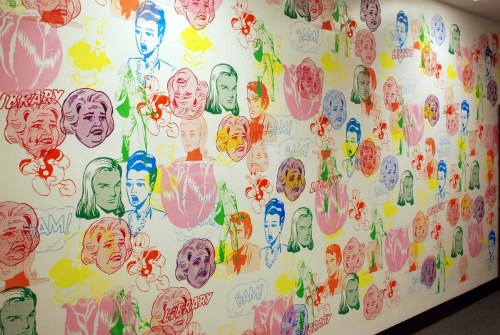When most people think of screen printing they usually visualize Warhol’s “Marilyn” or an indie rock gig poster or a pastel colored beachscape print, but not many folks know that screen prints can also be found printed directly on walls. This summer I had the opportunity to make a mural on a wall in Perkins library (in a hallway leading to the Gothic Reading Room) using a vertical screen printing technique that I’ve been researching. The project is the culmination of a Collaboration Development Grant from the Duke Council for the Arts. The grant also involved bringing Dutch artist Stefan Hoffmann to Duke to share his highly-developed vertical screen printing methods with me; students; staff; and Duke Art, Art History and Visual Studies professor Merrill Shatzman.

Beyond applying newly developed vertical screen printing techniques, the mural also gave me the opportunity to take advantage, and bring attention, to the RBMSCL’s Edwin and Terry Murray Comic Book Collection. In the past four years I’ve been using the Murray Collection as a teaching tool and resource for my Art of the Comic Book and Zines class. The mural design used appropriated images taken from an assortment of comics found in the collection. These included Marge’s Little Lulu and Tubby, Classics Illustrated – The Black Tulip, The Mark of Zorro and Walt Disney’s Donald Duck. I also used images taken from books found in the Lilly Library comics and graphic novels section (A Steve Ditko monograph and Love and Rockets, New Stories No. 1 by the Hernandez brothers). The images ranged from faces/heads to a standing figure to a tulip flower. I really wasn’t thinking about content but more about interesting shapes and forms—although I did use some text that related to the location of the piece.
The concept for the mural was to make a colorful and active design that used pop culture and street art/graffiti strategies (practiced by contemporary artists like Shepard Fairey, Faile, and Bäst and pioneered by artists like Polke, Rauschenberg, Lichtenstein, and Warhol). This included layering, repetition, and patterning, which can be easily implemented using the vertical screen printing method—one image per screen applied to the wall over and over again. This method also yields unexpected relationships between content and shapes that I find very exciting. The viewer can make their own narrative or allow it to be purely decorative. For this reason, the mural is untitled.
For more information about this project and other vertical screen printing information go to www.verticalscreenprinting.com.
Post contributed by Bill Fick, Visiting Assistant Professor of the Practice of Visual Arts. Thanks to Will Hansen, Assistant Curator of Collections, for coordinating this post.


